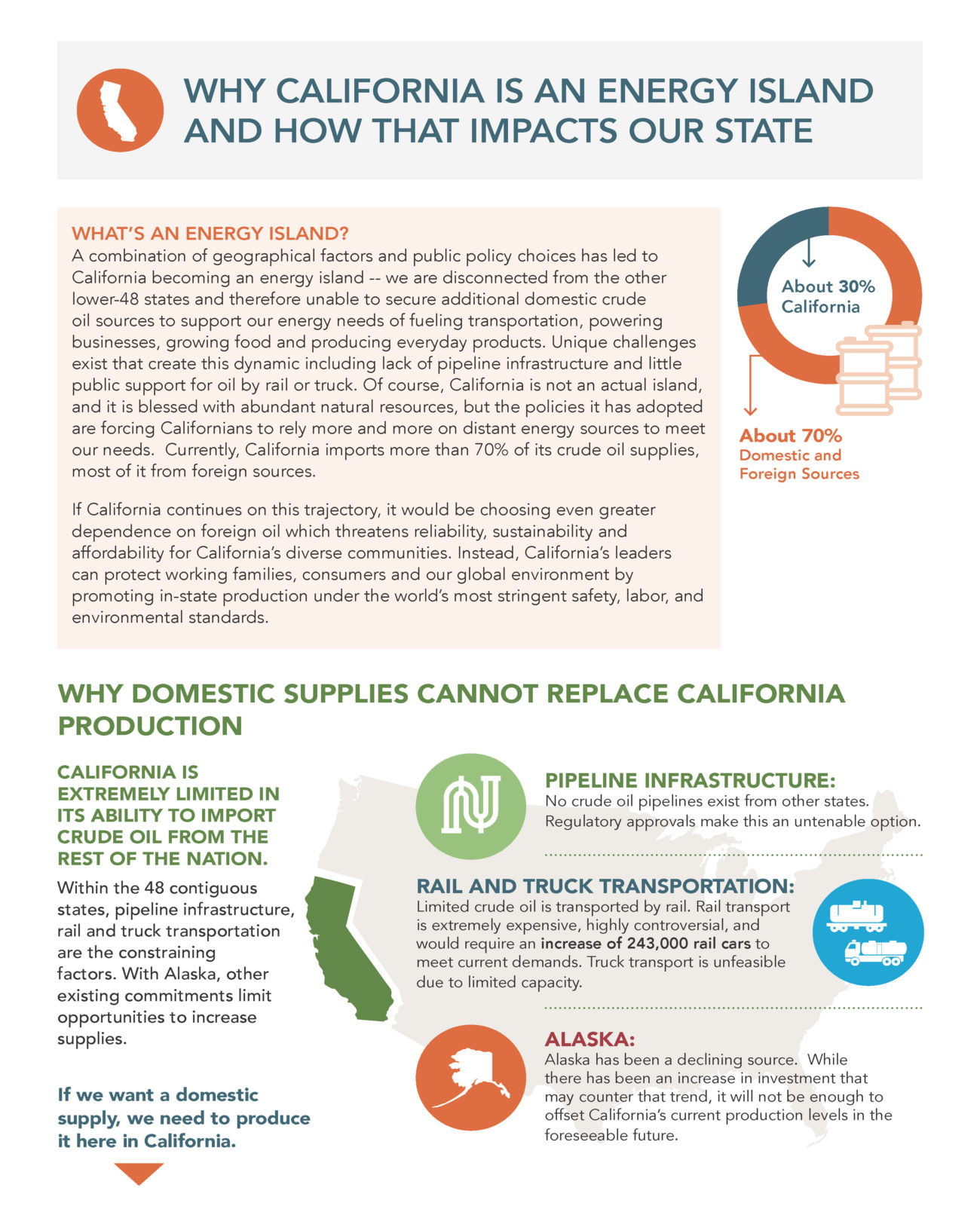A combination of geographical factors and public policy choices has led to California becoming an energy island — we are disconnected from the other lower-48 states and therefore unable to secure additional domestic crude oil sources to support our energy needs of fueling transportation, powering businesses, growing food and producing everyday products.
Unique challenges exist that create this dynamic including lack of pipeline infrastructure and little public support for oil by rail or truck. Of course, California is not an actual island, and it is blessed with abundant natural resources, but the policies it has adopted are forcing Californians to rely more and more on distant energy sources to meet our needs.
Currently, California imports more than 70% of its crude oil supplies, most of it from foreign sources. If California continues on this trajectory, it would be choosing even greater dependence on foreign oil which threatens reliability, sustainability and affordability for California’s diverse communities. Instead, California’s leaders can protect working families, consumers and our global environment by promoting in-state production under the world’s most stringent safety, labor, and environmental standards.
CALIFORNIA IS EXTREMELY LIMITED IN ITS ABILITY TO IMPORT CRUDE OIL FROM THE REST OF THE NATION: Within the 48 contiguous states, pipeline infrastructure, rail and truck transportation are the constraining factors. With Alaska, other existing commitments limit opportunities to increase supplies.
PIPELINE INFRASTRUCTURE: No crude oil pipelines exist from other states. Regulatory approvals make this an untenable option.
ALASKA: Alaska has been a declining source. While there has been an increase in investment that may counter that trend, it will not be enough to offset California’s current production levels in the foreseeable future.
RAIL AND TRUCK TRANSPORTATION: Limited crude oil is transported by rail. Rail transport is extremely expensive, highly controversial, and would require an increase of 243,000 rail cars to meet current demands. Truck transport is unfeasible due to limited capacity.
WHAT’S AT RISK FROM CALIFORNIA’S DEPENDENCE ON FOREIGN CRUDE OIL: Reliance on foreign energy imports create risks including reliability of our energy supply, market volatility, international turmoil, global environmental quality, and increased global air emissions.
RELIABILITY AND AFFORDABILITY: Volatile Markets Volatility exists within the global oil market due to geo-political and economic reasons. This includes: unforeseen circumstances, new costly investments, needs of other foreign countries like China, India and Europe, and trade wars
Strait of Hormuz A blockage of the Strait of Hormuz, the only sea passage from the Persian Gulf, is possible due to regional skirmishes. One-third of the world’s sea-borne oil passes through it every day.Unstable Foreign Countries Foreign countries may limit or shut off supplies due to embargoes or other means.
WORKER SAFETY AND ENVIRONMENTAL PROTECTIONS: Imported oil is not produced to California’s stringent safety, labor, and environmental standards.
CONTROL AND SECURITY: What’s our risk level for control? Is California okay handing over control of our energy needs to a remote source and putting our energy security at risk?
OUR COMMITMENT: Our industry is an active partner in helping California set an example to other states and other countries by producing the affordable, reliable energy we need in a way that safeguards public health, safety, and the environment. We share the state’s commitment to a vibrant economic, energy and environmental future that strengthens California’s working families, local employers, diverse communities and abiding values.

Over 200,000 Californians standing together to support safe, affordable and reliable local oil and gas production.